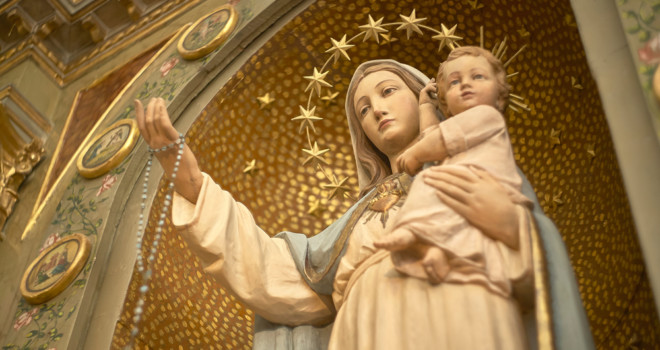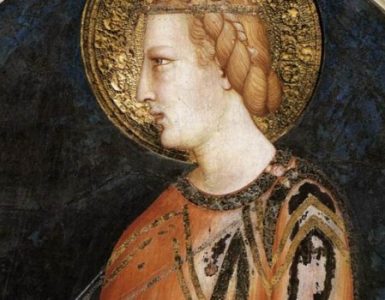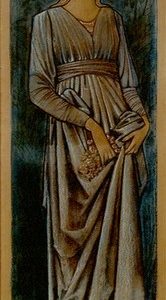We can distinguish in Mary a triple motherhood: her joyful motherhood at the crib, her sorrowful motherhood at the Annunciation and the Crucifixion, and her glorious motherhood in the Cenacle. At Bethlehem, she gave birth to Jesus according to the flesh; at the Annunciation and Calvary, she gave birth to souls at the price of her crucifying acceptance; in the Upper Room, she witnessed the birth of the Church and guided its first steps.
The Holy Spirit communicated Himself to Mary for the first time in the home of her parents, Joachim and Anne, on the day of her Immaculate Conception. The second great effusion was in her humble dwelling at the Annunciation, when Mary uttered her fiat of immolation, which was brought to completion only on the hill of the infamous gibbet where her Son writhed in agony before the whole world. At Pentecost, again in prayerful seclusion, the Holy Spirit poured out upon her the infinite riches of His grace. May we not believe that, if her love for men hastened the first miracle of Jesus at Cana, it is again her ardent desire that invites a swifter and more abundant coming of the Divine Consoler?
That is only a supposition, but one fact is certain: God willed to choose an identical abode for the spiritual presence of the Third Person of the Blessed Trinity and the sacramental presence of the Second Person. There are, as we know, two real presences: Jesus in the Sacred Host and the Holy Spirit in a soul in the state of grace.
This second presence, common to the Father and to the Son, is manifested visibly and more solemnly in the Upper Room than at Baptism, but is fundamentally identical in the baptismal infusion of the Divine Spirit in the soul made Christian. The presence of the baptismal fonts makes our churches most perfect images of the Upper Room. Formerly, the same Upper Room was the sanctuary of the eucharistic advent of the Savior and the descent of the Holy Spirit; now every parish church is a sanctuary of the sacramental coming of the Savior in the Host and of the spiritual coming of the Holy Spirit to the child being baptized.
A tradition expressing theological truth, and one that adequately explains the painting by either Mignard or Lebrun and inspired by Father Olier, gives the following detail of Pentecost: Mary and the twelve Apostles are united in prayer at the cherished site of the institution of the Holy Eucharist. The Holy Spirit descends, and it is she, the queen, who receives first and entirely the outpouring from on high. A single tongue of fire above her forehead divides so that one part rests over the head of each of the Apostles. It is fitting to point out here all the glory implied thereby to Mary. The Holy Spirit comes to Mary, and God charges her, the Mother of the human family, with the distribution of all grace. What is true of the effusion of the Holy Spirit on that day is equally true of every outpouring of grace: God gives nothing to earth without first confiding it to Mary, without causing the gift to pass through her hands.
Is it possible to gauge the measure of the plenitude of the divine fullness in the soul of Mary on that first Pentecost? Less than ever before! The immense plenitude of grace in Mary’s soul, unfathomable since her Immaculate Conception, has been increasing in a singular manner for fifteen years. It has been beyond measure since the superplenitude of the Annunciation — Spiritus Sanctus superveniet — a superplenitude that goes on increasing for thirty-three years, so that we might even say it approaches the infinite.
What can the Holy Spirit add to the divine life that is already hers? Nothing, according to our way of thinking, but in the eyes of God, Mary has not yet reached that degree of sanctity to which He wishes to raise her. That is why the Holy Spirit descends upon her again, and He who is abiding Love, the Love of the Father for the Son, expands the heart of Mary, increasing its capacity beyond human limits in order to enrich it immeasurably. It is not a question of enriching Mary’s heart for herself, but of enriching it for us.
She has been the supernatural Mother of souls for thirty-three years, since the saving consent of the Annunciation, when the Ecce Ancilla Domini was heard for the first time. Her maternal function was only a power then; now she is going to exercise it on behalf of the present and the future needs of humanity down through the ages. With what generosity will she exercise it!
Words fail us in praising such immensity. They betray us, they forsake us, they seek refuge in a revealing and eloquent silence that prays . . . and in a prayer that is silent.
The effects of the coming of the Holy Spirit were more apparent in the Apostles than in Mary. They began to speak the various languages needed for those whom they were to convert. If the effects of the descent of the Holy Spirit were less conspicuous in Mary than in the Apostles, they were, nevertheless, more profound. The divine effusion made her pass, not as the Twelve, from imperfection to holiness, but from one sublime degree of perfection to another even more sublime and which, according to the words of St. Thomas of Aquinas, attingit fines divinitatis, fringes on without quite attaining, of course, the limits of the divine life in God Himself.
Pure! Oh, certainly Mary was pure, the Virgin of the Quomodo fiet istud! How much more transparent is her purity now in the eyes of God. Humble! Oh, certainly she was humble, the gentle Virgin of the exaltavit humiles! But how much more humble now, after so many soul-stirring experiences and richer contacts with God have deepened her realization that all she is and has comes uniquely from Him who works within her. She abases herself in the knowledge of her own nothingness and of the infinite greatness of Him who is all-powerful.
Seat of Wisdom, Virgin most prudent, Mother most venerable: she has been all that for a long time. How much more now that the Spirit of wisdom, of prudence, and of holiness possesses her as an immense sea whose tides rise ever higher, whose conquering waves surge upward with constantly increasing powers.
The Virgin, since her consecration to God at the age of three, was filled with love for Him and souls, esteeming herself the servant of the Most High and of us all. But now who can conceive of her tremendous love for the Triune God, and for humanity, of whom she is the salvation, the consolation, and the refuge?
The Incarnation & the Eucharist
After Christ ascended to Heaven, Mary possessed Him only as all Christians possess Him — in the Eucharist. According to ancient tradition, Mary retired to the home of St. John or to the neighborhood of another apostle where she could, at each celebration of the breaking of the bread, participate in the renewal of the sacrifice and, by consuming the Victim, find again in Communion the ineffable joys of the intimate union of the nine months preceding the birth of Jesus.
The Incarnation was, in fact, the first union of the Virgin with the Living Bread come down from heaven. Not being a union through assimilation, it is not ordinarily referred to as Communion. Was not Mary the first chalice of the Blood of Jesus? Did not our Lord dwell in her during the nine months of expectation as in a veritable ciborium? How much richer was she than all the beautiful ciboria of gold or silver? At the Crib, was not Mary the first ostensorium of her Son, showing Him to the shepherds, to the Magi, and to the world?
Now she finds the past under another form; the consecrated Bread the Apostle places on her lips is Jesus formed from her own flesh and with whom her body is again united. The child is something of its mother, formed as it is from her own substance. In receiving the Body and Blood of Jesus, she finds again something of herself, and this something of herself, formed from her own substance, is the Body and Blood of the Man-God.
This Communion is absolutely unique in its kind and incomparably superior to any other union. We would try in vain to appreciate the benefit the Blessed Virgin received from each contact with her eucharistic Son. Ancient tradition mentions a special feast to celebrate the First Communion Day of the Blessed Virgin. History has recorded and tried to commemorate the value of the Communions of some saints, such as St. Stanislaus Kostka, St. Francis of Assisi, and St. Thérèse of the Child Jesus. What is the ardent love of the saints compared with the devoted love of the Blessed Virgin at the sacrifice of the Mass or at Holy Communion? Catholic fervor will profit more by meditation on the beauty of the bond that unites Mary to Jesus than by the mere remembrance of Mary’s eucharistic devotions in the mystery of the altar.
The Eucharist is a sacrifice and at the same time a sacrament. No one denies that, as a sacrifice, the Mass is identically the same oblation as that of Calvary: the Priest and the Victim are the same; only the setting is different. Jesus, the sole Mediator, willed to associate Mary with the Cross as the co-redemptrix; and, because God is faithful, this plan continues. Then, at every mystical renewal of the Sacrifice of the Cross — that is, at each Mass — the oblation of the Savior is made under the same conditions: Mary is present, keeping her station with Jesus.
As a sacrament, the Eucharist has for its object to communicate life. This life, our Lord, the God-Man, possessed because of the fiat of Mary, depending wholly on her free will. Again God is faithful, and His plan does not change. Each time Christ becomes present in the hands of the priest, the life given to us by the words of consecration comes originally from Mary. Is it not, then, through a special intervention of the divine Mediatrix, the Blessed Virgin Mary, that this life is communicated to us?
It would, therefore, be a fundamentally Catholic practice at Mass to offer Jesus to the Father through Mary: therein would lie the ascent of praise; and, likewise, in Holy Communion, to ask for grace through Mary: thereupon would follow the descent of favors and benedictions. We have Mary to offer, Mary to obtain; her intercession to raise to Heaven and her intercession to draw down to earth. At this moment and in the sacrament in which Jesus is most Jesus, would not Mary be active in the manner that would be most truly Mary?
✠
This article is adapted form a chapter in Fr. Plus’s book, The Little Book of the Blessed Virgin Mary. It is available as an ebook or paperback from your favorite bookseller or online through Sophia Institute Press.
image: Madonna and Child in Gavello via Filippo Carlot / Shutterstock.com













